人教版七年级上册英语教案[全册]
- 格式:doc
- 大小:749.50 KB
- 文档页数:60

人教版初一英语上册教案15篇人教版初一英语上册教案【篇1】教学年级:七年级课程名称:Unit 3 Why do you like koalas?教材版本:人民教育出版社授课时间:40分钟(一)学生分析:1.本班学生对学习英语较感兴趣,能积极参加各种调查、采访、表演等实践活动。
2.学生学习动机明确,学习态度积极主动,能主动与他人合作,相互帮助,共同完成学习任务,遇到问题敢于主动向老师和同学请教,能大胆用英语交流。
(二)教材分析:本课时的内容是义务教育课程标准实验教科书英语新目标“Go for it!”七年级的《Unit 3 Why do you like koalas?》第一课时,主要话题是学习动物名称,并讨论喜好某种动物的原因。
通过话题的讨论喜欢动物的原因,增强了动物名称的词汇量,还增强课堂学习趣味性。
(三)教学目标语言知识目标1.学习有关动物的名词:tiger elephant koala dolphin panda lion penguin giraffe2.学习并运用品质的.形容词:cute smart shy ugly clever beautiful friendly quiet lazy来描述动物.3.掌握下列句型Why do you like…?. Because they’re….使学生熟练表达喜好并陈述原因。
语言能力目标1.学生能熟练谈论自己喜爱的动物并给出理由。
2.学生的口语和书面表达能力得到提高。
3.培养学生主动参与语言实践活动的能力,在游戏和小组竞赛中培养学生乐于表达、勇于展示自我的能力,从而树立学习英语的信心,获取成功的喜悦。
情感目标1.通过学习要培养学生自觉保护动物的意识。
2.培养学生积极参与,发扬团队合作的精神和竞争意识。
(四)教学策略1、教学方法Task-based, Language Teaching,途径:Guesing game, group work, pair work, survey, Internet teaching.2、教学辅助手段采用多媒体电脑投影图片,充分利用网络教材资源,扩大学生的知识面,激发学生的兴趣和求知欲。
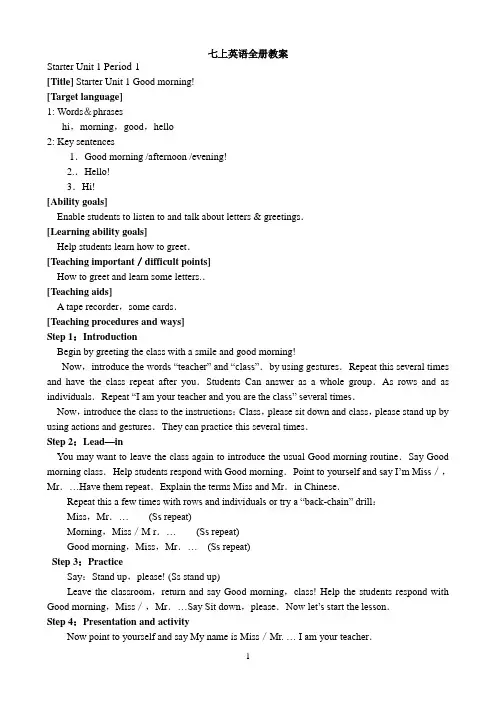

人教版(新目标)初中英语七年级上全册教案(共117页)--本页仅作为文档封面,使用时请直接删除即可----内页可以根据需求调整合适字体及大小--人教版(新目标)初中七上Starter Unit 1 Good morning!教案Period One教学目标:1. 学会打招呼的用语:Hello! / Good morning! / Good afternoon! / Good evening!2. 识别和掌握八个人名: Alice, Bob, Cindy, Dale, Eric, Frank, Grace, Helen教学重点、难点:1.词汇:Alice, Bob, Cindy, Dale, Eric, Frank, Grace, Helen2.句型:Hello! Good morning!教学过程:Step 1. Warming-up1. 课前—上课铃响教师就播放Good morning歌曲。
2. 师生初次见面,教师通过自我介绍和问候学生,让学生放轻松,消除与教师间的陌生感,开始亲近教师。
教师自我介绍并用Hello! / Good morning! 问候学生。
帮助学生用Hello! / Good morning! 作回应。
Step 2. Play a game.绝大多数学生都会背诵26个字母表,因此学生参与这个游戏会相当积极。
通过这个游戏首先可以锻炼他们迅速反应的能力;以英语名字作为奖励(老师提前准备好很多的英文名字),也使学生较有新鲜感,让他们自己选择自己的名字,使他们会更容易记住自己的名字。
Play the game like this: Teacher says a letter, for example C, then let the Students tell the letters which is before and after C. The one who says B, D first is the winner. The winner can get a chance to choose an English name first.Step 3. Presentation1.用预先制作的图片或挂图介绍八个人物和姓名。
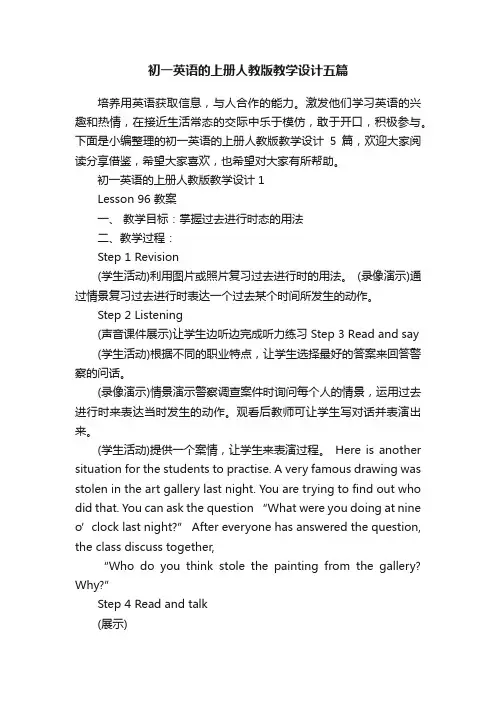
初一英语的上册人教版教学设计五篇培养用英语获取信息,与人合作的能力。
激发他们学习英语的兴趣和热情,在接近生活常态的交际中乐于模仿,敢于开口,积极参与。
下面是小编整理的初一英语的上册人教版教学设计5篇,欢迎大家阅读分享借鉴,希望大家喜欢,也希望对大家有所帮助。
初一英语的上册人教版教学设计1Lesson 96 教案一、教学目标:掌握过去进行时态的用法二、教学过程:Step 1 Revision(学生活动)利用图片或照片复习过去进行时的用法。
(录像演示)通过情景复习过去进行时表达一个过去某个时间所发生的动作。
Step 2 Listening(声音课件展示)让学生边听边完成听力练习 Step 3 Read and say (学生活动)根据不同的职业特点,让学生选择最好的答案来回答警察的问话。
(录像演示)情景演示警察调查案件时询问每个人的情景,运用过去进行时来表达当时发生的动作。
观看后教师可让学生写对话并表演出来。
(学生活动)提供一个案情,让学生来表演过程。
Here is another situation for the students to practise. A very famous drawing was stolen in the art gallery last night. You are trying to find out who did that. You can ask the question “What were you doing at nine o’clock last night?” After everyo ne has answered the question, the class discuss together,“Who do you think stole the painting from the gallery? Why?”Step 4 Read and talk(展示)Read the table about what David was doing at different times yesterday, then ask and answer in pairs.(录像演示)情景演示询问过去某个时间点正在进行的动作,看后让学生进行模仿练习。
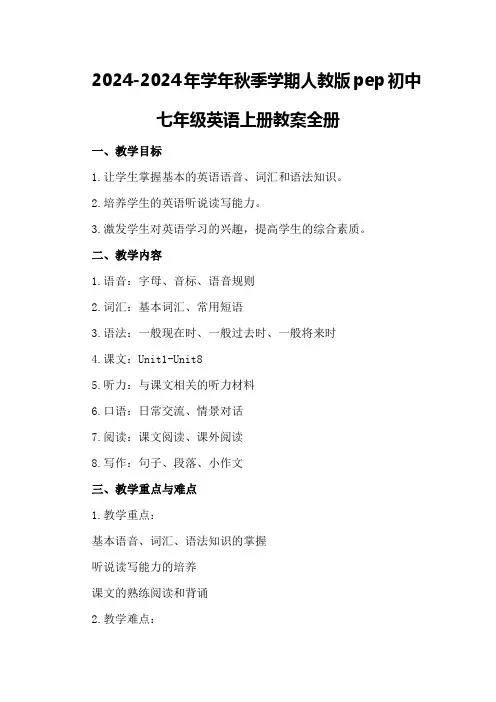
2024-2024年学年秋季学期人教版pep初中七年级英语上册教案全册一、教学目标1.让学生掌握基本的英语语音、词汇和语法知识。
2.培养学生的英语听说读写能力。
3.激发学生对英语学习的兴趣,提高学生的综合素质。
二、教学内容1.语音:字母、音标、语音规则2.词汇:基本词汇、常用短语3.语法:一般现在时、一般过去时、一般将来时4.课文:Unit1-Unit85.听力:与课文相关的听力材料6.口语:日常交流、情景对话7.阅读:课文阅读、课外阅读8.写作:句子、段落、小作文三、教学重点与难点1.教学重点:基本语音、词汇、语法知识的掌握听说读写能力的培养课文的熟练阅读和背诵2.教学难点:音标发音的准确性语法规则的灵活运用课外阅读的理解与分析四、教学进度安排1.第一周:Unit11.1Greetingsandintroductions 1.2Numbersandages1.3Colors2.第二周:Unit22.1Schoolsubjects2.2Classroomobjects2.3Dlyroutines3.第三周:Unit33.1Foodanddrink3.2Describingfood3.3Makingrequests4.第四周:Unit44.1Familymembers4.2Describingpeople4.3Talkingaboutfamily5.第五周:Unit55.1Time5.2Daysoftheweek5.3Activities6.第六周:Unit66.1Weather6.2Clothing6.3Describingtheweather7.第七周:Unit77.1Inthelibrary7.2Intheclassroom7.3Inthesupermarket8.第八周:Unit88.1Sports8.2Describingsports8.3Talkingaboutsports五、教学方法1.采用任务型教学法,让学生在实际语境中学习英语。
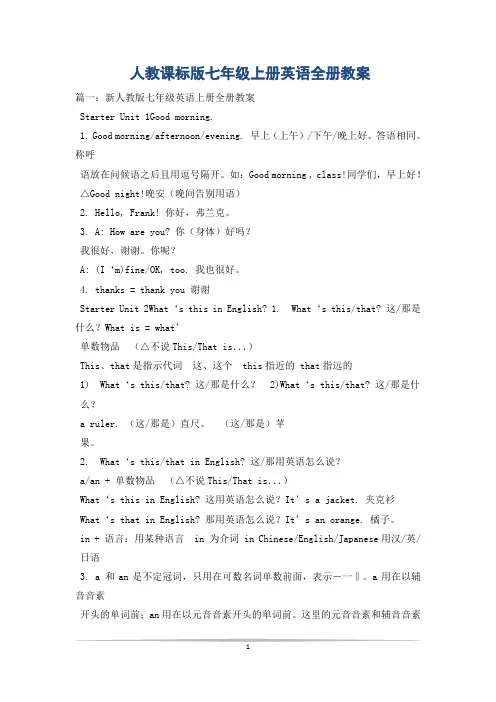
人教课标版七年级上册英语全册教案篇一:新人教版七年级英语上册全册教案Starter Unit 1Good morning.1. Good morning/afternoon/evening. 早上(上午)/下午/晚上好。
答语相同。
称呼语放在问候语之后且用逗号隔开。
如:Good morning , class!同学们,早上好!△Good night!晚安(晚间告别用语)2. Hello, Frank! 你好,弗兰克。
3. A: How are you? 你(身体)好吗?我很好,谢谢。
你呢?A: (I‘m)fine/OK, too. 我也很好。
4. thanks = thank you 谢谢Starter Unit 2What‘s this in English? 1. What‘s this/that? 这/那是什么?What is = what’单数物品(△不说This/That is...)This、that是指示代词这、这个 this指近的 that指远的1) What‘s this/that? 这/那是什么? 2)What‘s this/that? 这/那是什么?a ruler. (这/那是)直尺。
(这/那是)苹果。
2. What‘s this/that in English? 这/那用英语怎么说?a/an + 单数物品(△不说This/That is...)What‘s this in English? 这用英语怎么说?It’s a jacket. 夹克衫What‘s that in English? 那用英语怎么说?It’s an orange. 橘子。
in + 语言:用某种语言 in 为介词 in Chinese/English/Japanese用汉/英/ 日语3. a 和an是不定冠词,只用在可数名词单数前面,表示―一‖。
a用在以辅音音素开头的单词前;an用在以元音音素开头的单词前。
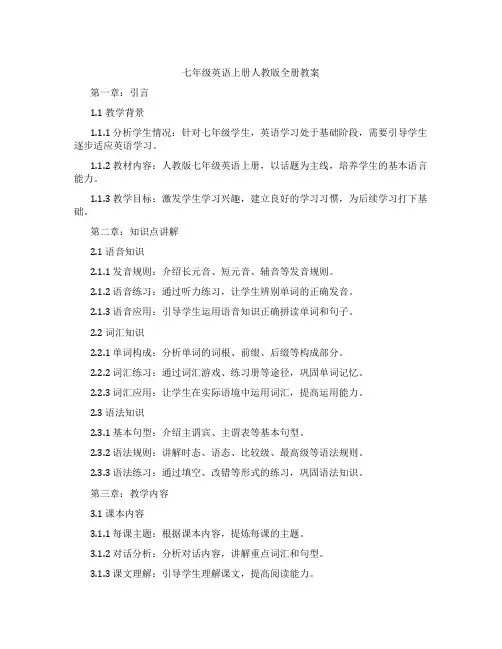
七年级英语上册人教版全册教案第一章:引言1.1 教学背景1.1.1 分析学生情况:针对七年级学生,英语学习处于基础阶段,需要引导学生逐步适应英语学习。
1.1.2 教材内容:人教版七年级英语上册,以话题为主线,培养学生的基本语言能力。
1.1.3 教学目标:激发学生学习兴趣,建立良好的学习习惯,为后续学习打下基础。
第二章:知识点讲解2.1 语音知识2.1.1 发音规则:介绍长元音、短元音、辅音等发音规则。
2.1.2 语音练习:通过听力练习,让学生辨别单词的正确发音。
2.1.3 语音应用:引导学生运用语音知识正确拼读单词和句子。
2.2 词汇知识2.2.1 单词构成:分析单词的词根、前缀、后缀等构成部分。
2.2.2 词汇练习:通过词汇游戏、练习册等途径,巩固单词记忆。
2.2.3 词汇应用:让学生在实际语境中运用词汇,提高运用能力。
2.3 语法知识2.3.1 基本句型:介绍主谓宾、主谓表等基本句型。
2.3.2 语法规则:讲解时态、语态、比较级、最高级等语法规则。
2.3.3 语法练习:通过填空、改错等形式的练习,巩固语法知识。
第三章:教学内容3.1 课本内容3.1.1 每课主题:根据课本内容,提炼每课的主题。
3.1.2 对话分析:分析对话内容,讲解重点词汇和句型。
3.1.3 课文理解:引导学生理解课文,提高阅读能力。
3.2 拓展内容3.2.1 相关话题:针对课本内容,拓展相关话题。
3.2.2 听力练习:选择合适的听力材料,提高学生听力水平。
3.2.3 口语表达:组织口语交流活动,提高学生口语表达能力。
第四章:教学目标4.1 知识目标4.1.1 掌握基本的语音、词汇和语法知识。
4.1.2 能够听懂、说出一日常用语。
4.1.3 理解课本内容,具备一定的阅读和写作能力。
4.2 能力目标4.2.1 提高学生的听、说、读、写四项基本技能。
4.2.2 培养学生的语言运用能力和团队协作能力。
4.2.3 培养学生的跨文化交际意识。
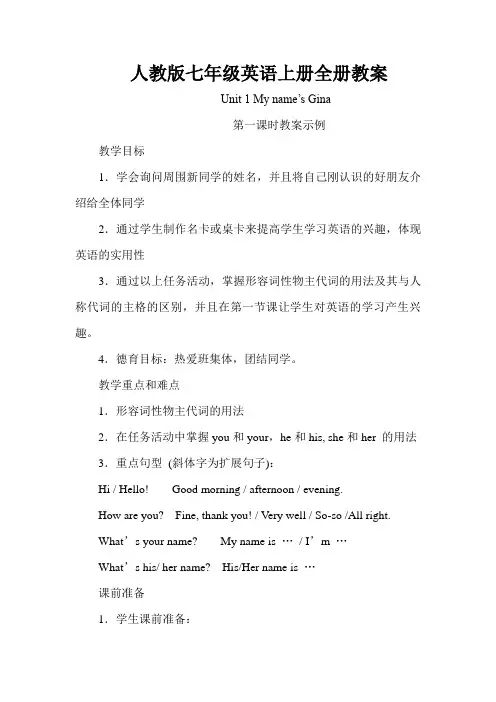
人教版七年级英语上册全册教案Unit 1 My name’s Gina第一课时教案示例教学目标1.学会询问周围新同学的姓名,并且将自己刚认识的好朋友介绍给全体同学2.通过学生制作名卡或桌卡来提高学生学习英语的兴趣,体现英语的实用性3.通过以上任务活动,掌握形容词性物主代词的用法及其与人称代词的主格的区别,并且在第一节课让学生对英语的学习产生兴趣。
4.德育目标:热爱班集体,团结同学。
教学重点和难点1.形容词性物主代词的用法2.在任务活动中掌握you和your,he和his, she和her 的用法3.重点句型(斜体字为扩展句子):Hi / Hello! Good morning / afternoon / evening.How are you? Fine, thank you! / Very well / So-so /All right.What’s your name? My name is …/ I’m …What’s his/ her name? His/Her name is …课前准备1.学生课前准备:利用网络查阅中英文姓名及初次见面时各国或各地风俗,礼仪体会它们的不同之处;准备硬纸片和水彩笔;用英文介绍自己的姓、名。
2.教学器材:录音机、电脑、图片。
3.教学课件:中英文名字展示片。
教学设计Tasks Students’ activities Teacher’s activities1. Game: ask and answer the question: What’s your name? Students make a self-introduction and pass the sentences one by one. At first, teacher makes a self-introduction.2.Two students act out how to greet people. Act out the greeting forms they are familiar with or they find on net. Show the students the pictures of other countries’customs with computer.3. See who can make the most friends and get the most information. Then report their results with his or hers. Move around to make friends with the ones they are interested in. Make the students move around to make friends with others.4. Design and make their name cards . Design and make their name cards in groups. Ask them to design their name cards and see which group is the best.教学过程设计任务一:结识新朋友。
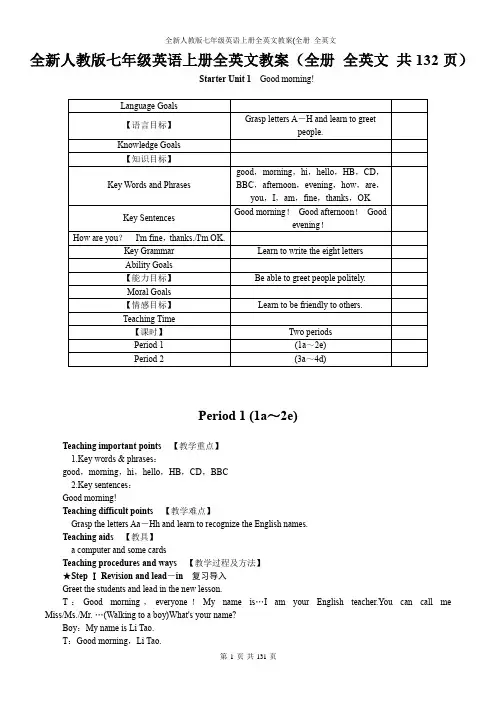
全新人教版七年级英语上册全英文教案(全册全英文全新人教版七年级英语上册全英文教案(全册全英文共132页)Starter Unit 1Good morning!Period 1 (1a~2e)Teaching important points【教学重点】1.Key words & phrases:good,morning,hi,hello,HB,CD,BBC2.Key sentences:Good morning!Teaching difficult points【教学难点】Grasp the letters Aa-Hh and learn to recognize the English names.Teaching aids【教具】a computer and some cardsTeaching procedures and ways【教学过程及方法】★Step Ⅰ Revision and lead-in复习导入Greet the students and lead in the new lesson.T:Good morning,everyone!My name is…I am your English teacher.You can call me Miss/Ms./Mr. …(Walking to a boy)What's your name?Boy:My name is Li Tao.T:Good morning,Li Tao.Boy:Good morning,Ms./Mr. …(Help the student to respond correctly if necessary.)The teacher writes “Good morning,Li Tao.”on the blackboard.★Step Ⅱ Self-studying and guiding自学指导Self-study guide 1:Self-study the new words and English names:good,morning,hi,hello,Alice,Bob,Cindy,Dale,Eric,Frank,Grace,Helen.Learn to pronounce them according to the phonetic symbols(音标).And you can listen to the tapes to help you pronounce them correctly or ask others for help.Self-study guide 2:Try reading the sentences in 1a and try to tell boys' names from girls' names.Self-study guide 3:Self-study 2c and learn to write the eight letters.Questions for thinking:1.Do you know how to greet people in the morning?2.Do you know how to write the eight letters Aa,Bb,Cc,Dd,Ee,Ff,Gg,Hh?The teacher walks around the classroom to watch and help the students study while the students are self-studying.Time for questions:Discuss the writing of the eight letters.★Step Ⅲ Check up检查核对Check up 1:Words teaching:Ask a few students to read the new words and help them correct the mistakes in pronunciation if necessary.Check up 2:Ask some students to make a conversation with their partner and see if they can respond correctly.And ask students to fill in the blanks:Boys' names:________________________________________________________________________ Girls' names:________________________________________________________________________Check up 3:Write the small letters for these big letters:A____B____C____D____E____F____G____H____★Step Ⅳ Cooperative inquiry合作探究1.Listening (1b)Play the recording of 1a,students listen and repeat.2.Pair workPractice the conversations in the picture and then greet your partner.(1c)Sample:A:Good morning,Zhang Wen!/Hello,Zhang Wen!B:Good morning,Li Yan!/Hello,Li Yan!3.Act outAsk some pairs of students to act out their dialogs in front of the class.4.Finish 2a and 2b.5.Discussion (2e)Talk about what these letters HB,CD,BBC mean.★Step Ⅴ Practice练习Write the missing big letter or small letter for each pair.(2d)★Step Ⅵ Test测试Choose the best answer.()1.书写英文字母时,占三格的是________。
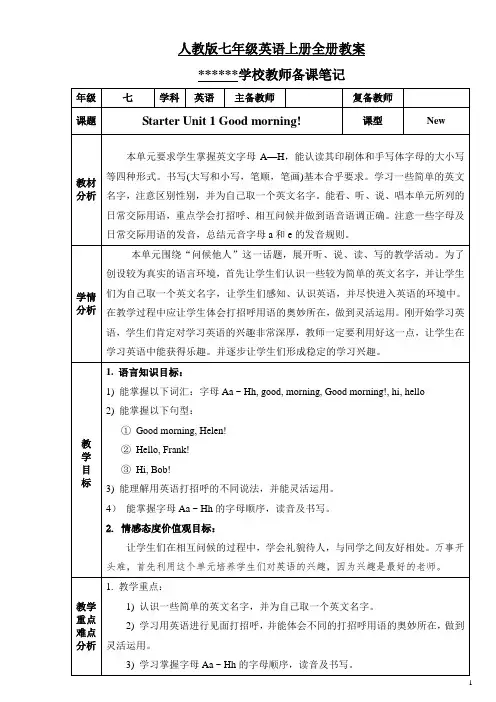
人教版七年级英语上册全册教案******学校教师备课笔记学校教师备课笔记Revise some school things byasking questions. e.g.: What ’s this? Is this a …? How do you spell it?etc.Learn the new words in, on, under, behind … by helping the teacher find the lost things. e.g.: T: Where ’s my English book? S1: It ’s here. / I think it ’s …T: Oh, it ’s on the desk. … T: Where ’re my color pencils? S2: … Teach the new word “where ” and the use of “they ”. Consolidate the prepositions by looking at thescreen and answer thequestions: Where ’s … ?Where ’re …?Hide and look for thingsShow the students a picture of a room, tell them this is a bedroom, let the students list the things in it first. Then show them the whole picture, teach the new words, ask where the things are, let the students answer, using the prepositions.Repeat with a sitting room and a study, teach the new words and practice in the same way.Section A, 1a: Match the words with the things in the picture. Students do it individually first, then check the answers. Section A, 1c: Make up dialogues in pairs, using the things in the picture.Chatting. Chat with the students about the things around the room by showing them pictures. Ask the students to spell the new words. Section A, 2a. Revise what the things are. Play the tape for students and let them number them. Section A, 2b. Play the tape again, students number the things [1-6] in the picture. Imitate the dialoguesSection A, 2c. Look at the picture in 2b again. Students use general questions to ask and answer about the things in it.Ask some students to report their answer like this: In Picture 1, the pencil case is …In Picture 2, the pencil case is…; In Picture 1, the books are …In Picture 2, the books are …Present short dialogues, using pictures or objects to help. Dialogue 1: A: Where’s my bag? B: I don’t know. Is it on the sofa? A: No, it isn’t. Dialogue 2: A: Where’re my books? B: I don’t know. Are they on the bed? A: Yes, they are. Teach “don’t =do not”, “know”. Check the homework in Period One. Make reports to share the information they got from the friends or teachers, and give their simply assessment.Let the students makesimilar dialogues according to the pictures in Section A, 3a&3c. Put the dialogue in the right order.( Section A, 3a.) Listen and imitate the dialogues in Section A, 1b.answer make similar dialogues according to the pictures in Section A, 3a&3c.Ask some pairs to act out the dialogues in Section A, 2a & 2b. Show the students a picture of a room. Let the students say likethis: The ID card is on the table. The books are on the chair. Let some able students list some new words. Practice reading them. Match the new words with the things in thepicture. (Section B, 2a.) Pairwork. Talk about the picture.( Section B, 1b&1c.)Play the tape twice for students to listen and circle the things Tommy wants from his room. Check the answers. ( Section B, 2a. )Listen again.Show a picture of a roomwith a few things in it, give the students a short note about the things around the room to read, let the students try to find out thedifferences between the reading material and the picture. Circle the mistakesin the reading material. Make an orally report by looking at the picture again. The students read the note silently and draw the missing things in the picture. ( Section B, 3a.) (为了节省时间,教师可以让学生在图中标出数字来替代画图。

人教版7上英语教案5篇(实用版)编制人:__审核人:__审批人:__编制单位:__编制时间:__年__月__日序言下载提示:该文档是本店铺精心编制而成的,希望大家下载后,能够帮助大家解决实际问题。
文档下载后可定制修改,请根据实际需要进行调整和使用,谢谢!并且,本店铺为大家提供各种类型的实用资料,如工作计划、汇报材料、心得体会、发言稿、合同大全、申请书、演讲稿、作文大全、教案大全、其他资料等等,想了解不同资料格式和写法,敬请关注!Download tips: This document is carefully compiled by this editor.I hope that after you download it, it can help you solve practical problems. The document can be customized and modified after downloading, please adjust and use it according to actual needs, thank you!Moreover, our store provides various types of practical materials for everyone, such as work plans, presentation materials, reflections, speech drafts, contract summaries, application forms, speech drafts, essay summaries, lesson plans, and other materials. If you want to learn about different data formats and writing methods, please stay tuned!人教版7上英语教案5篇教案的实施需要教师具备良好的组织和管理能力,以确保教学过程的顺利进行,编写详细的教案可以帮助我们更好地运用各种教学方法和策略,提高教学的多样性,以下是本店铺精心为您推荐的人教版7上英语教案5篇,供大家参考。
七年级英语教案2011-----2012学年度第一学期人教版七年级上册英语全册教案Unit 1 My name’s GinaPeriod One课前准备教师:准备游戏时所用的图片(食物、蔬菜、动物)。
学生:准备表演时所需道具(服装、假发)。
教学设计Step One :Present the sentence patterns.1.Play a game “How many words do you know?”(利用小游戏调动学生的积极性,同时通过对冠军的介绍引出本课。
)Teacher: After the study of the first three starters, I thinkmost of the students must have known a lot of words. How manywords do you know? Let’s play a game to see who know? Let’s play a game to seewho knows the most.(Divide all the students into several groups and show a picture(图片略) to them with the computer. Every group can choose two students to join. They are asked to come to the blackboard and write down the words in 30 seconds.)(Group 2 is the champion group. They can write 11 words.)2.Introduce the champion group to the class.(引课方式贴近生活,学生易于接受)Teacher: Congratulations, now Group 2 is the champion. But I don’t know your names. Would you like to introduce yourselves to us?S1& S2:Yes.S1:Hello.My name is Li Lei. Nice to meet you.Ss: Hello, Li Lei. Nice to meet you ,too.Ss: Hello! What’s your name?S2:I’m Sun Ping. How do you do?Ss: How do you do ?Step Two: Drills.1.Make introductions.(通过句型的操练使学生更加熟练掌握所学的句式。
人教版七年级上册英语教案16篇人教版七年级上册英语教案(精选篇1)一、复习指导思想新授课结束后,期末考试前,指导学生进行期末复习,主要复习基础知识,提高做题能力,训练阅读、听力与写作,使学生能够举一反三,熟练掌握知识点与考点.二、学生学习水平现状分析学生的主要问题是基础薄弱,做题能力参差不齐,优秀的学生不多,成绩有待于提高的学生比较多,一部分同学学习惰性强。
三、复习时间:十七周至十八周(共10课时)四、复习重点1、基础知识:unit1—unit8:重点词汇、短语、句型2、语法:(1)动词不定式(2)动名词(3)被动语态(4)形容词相关句型的运用(5)副词的运用(6)原因状语从句(7)过去进行时3、阅读训练(报纸阅读材料)4、听力(报纸、导学案套题听力训练)5、话题写作:肢体语言,义务工作,传统技艺,卡通漫画、动物保护、动物描写、未来生活畅想6、复习中注重讲练结合,及时反馈,及时检测五、课时安排时间为两周,具体计划如下:十七周(周一)unit1、2重点词组句型小结;语法训练(报纸2、3版)十七周(周二)unit1、2知识点练习,话题写作训练(报纸4版)十七周(周三)unit3、4重点词组句型小结;语法训练(报纸5、6版)十七周(周四)unit3、4知识点练习,话题写作训练(报纸7版)十七周(周五)unit5、6重点词组句型小结;语法训练(报纸8、9版)十八周(周一)unit5、6知识点练习,话题写作训练(报纸10版)十八周(周二)unit7、8重点词组句型小结;语法训练(报纸11、12版)十八周(周三) unit7、8知识点练习,话题写作训练(报纸13版)十八周(周四)模拟套题(报纸31版)(综合测试一)十八周(周五)模拟套题(报纸32版)(综合测试二)六、复习措施1、单词过关。
每天重点句子听写2、语法复习注重讲练结合,引导学生说出重点与易错点3、加强整理英语学习档案4、对于阅读训练有指导,有检测。
七年级上册教案Starter Unit 1 Good morning !教学重点:Aa --- Hh的字母教学。
Hello! Good morning. Good afternoon. Good evening.-- How are you? -- I’m fine, thanks. And you? -- I’m OK.教学难点:课本中英语人名的学习和大、小写字母的学习及书写。
单元课时:5个课时第一课时:完成Section A 1a, 1b第二课时;完成Section A 2a, 2b,2c, 2d, 3, 4a第三课时:完成Section A 4b, 4c, Section B 1, 2a, 2b第四课时:完成Section B 3a, 3b, 4, 5第五课时:完成Self Check and Just for Fun教学目标:A. 语言知识目标词汇:Letters Aa --- Hh八个人名:Alice, Bob, Cindy, Dale, Eric, Frank, Grace, Helen句型:Good morning. Good afternoon. Good evening.-- How are you? -- I’m fine, thanks. And you? -- I’m OK.B. 语言技能目标通过游戏等多种形式的学习活动,培养学生对初学知识的听、说、读、写能力和灵活运用初学的日常交际用语的能力。
C. 情感目标1. 激发学生学习英语的兴趣,发挥学生学习英语的积极性和主动性。
2.通过小组活动,培养学生的合作意识和团队精神。
3.在活动中培养学生的思维能力和创新能力。
Period OneTeaching materials:Section A 1a,1bTeaching aims:1.识别和掌握八个人名。
2.学会早上见面打招呼的用语。
Language points1.词汇:Alice, Bob, Cindy, Dale, Eric, Frank, Grace, Helen2.句型:Hello! Good morning!Difficulties:八个人名的掌握Teaching procedures:Step 1. Warming-up1.T wears a name card with an English name on it, then points to the name card and have an introduction.2. Greet the whole class and help them to say, Hello, … Good morning, …Step 2. Play a game.T gets ready for a list of English names for boys and girls.Play the game like this:T says a letter, for example C, then let the Ss tell the letters which is before and after C. The one who says B, D first is the winner. The winner can get a chance to choose an English name first or he can give the chance to his friend.Step 3. PresentationShow a picture of a girl and give the name under the picture, teach Alice. In the same way teach the other seven names.Step 4.GameShow the pictures of these eight children as quickly as possible. Let the Ss tell the names of these children. ( The winner can have a chance to choose an English name.)Step 5. PresentationShow a picture with Eric, let Ss guess what Eric wants to say to us. The answer is : Hello! or Good morning. Then help them to say: Hello, Eric! or Good morning, Eric.Step 6. Work on 1aPlay the recording for the first time, Ss only listen.Play the recording a second time. Ss repeat.Step 7. Work on 1bSs practice the conversations in pairs. T moves around the classroom when Ss are practicing. Give them some help if needed.Ask Ss to practice greeting each other. They can use their Chinese names if they wish. Encourage them to use their English names if they can. Ask them to practice using all the different greetings taught in Activity 1a. HomeworkMake a name card like the teacher’s by themselves and learn how to read their own names.Period TwoTeaching materials:Section A2a-4aTeaching aims:1.学会正确朗读和书写Aa-Hh八个字母。
人教版初中七年级上册英语教案(完整版)一、教学内容Unit 1 你好Lesson 1 你好吗1. 教学目标:- 研究如何问候和回应问候的方式- 掌握与他人交流的基本问答方式- 学会用英语自我介绍2. 教学重点:- 掌握如何用英语问候和回应问候的方式- 学会在对话中使用一些常见的英语短语- 能够简单介绍自己的姓名、国籍和年龄3. 教学过程:- 导入新课,引导学生复英语问候语- 引入新的问候方式和回应,通过示范和练加深学生理解- 分组进行对话练,鼓励学生运用新学的问候方式与他人交流- 引导学生进行自我介绍,帮助他们掌握相关的英语表达4. 板书设计:- 问候语- Hello!- Hi!- How are you?- I'm fine, thank you.- 自我介绍- My name is [name].- I am from [country].- I am [age] years old.5. 作业要求:- 完成课堂练册上的相关练- 准备下节课的自我介绍Lesson 2 你是谁(以下内容略去不写)Unit 2 我的家(以下内容略去不写)二、教学目标在初中七年级上册英语教学中,我们旨在通过教授Unit 1和Unit 2的内容,帮助学生学会基本的英语问候和自我介绍方式,以及描述家庭成员和家庭的基本词汇。
通过各种实践活动和练,学生将能够在日常生活中简单地应用这些英语表达方式。
三、教学方法- 情景教学法:通过创设真实情景,引导学生使用所学知识进行对话练。
- 归纳法:通过提供示范和练,让学生总结语言规律和表达方式。
四、教学资源- 人教版初中英语教材《七年级上册》- 课件和多媒体设备- 课堂练册五、教学评估通过课堂练、对话练和个人介绍的方式,对学生对所学内容的掌握程度进行评估。
六、教学反馈及时反馈学生的研究情况,鼓励他们在研究过程中的积极表现,并针对学生的不足之处提出改进建议。
七、教学改进根据学生的研究情况和反馈意见,不断优化课堂教学过程,提高学生的研究效果。
七年级英语上册人教版全册教案一、第一单元:My name's Gina,my name's L cy1. 教学目标:了解并掌握自我介绍的常用句型,如“My name's”和“I'm from”。
能够正确书写自己的姓名和来自的地方。
学会使用问候语与人打招呼。
2. 教学内容:单词:name, I'm, from, where, am, class, grade, school, in, my 句型:1. My name's 2. I'm from对话:1. A: My name's Gina. B: Nice to meet you, Gina.2. A: I'm from Beijing. B: Oh, really? I'm from Shangh.3. 教学步骤:1) 热身活动:让学生自由交谈,互相问候。
2) 引入新课:展示图片,引导学生说出自己和他的家乡。
3) 讲解单词和句型:讲解单词和句型的用法。
4) 练习对话:让学生分角色扮演,进行对话练习。
5) 总结:检查学生的学习效果,进行反馈。
二、第二单元:What's your name?1. 教学目标:掌握询问别人姓名的常用句型“What's your name?”和回答“My name's”。
学会介绍自己的年龄和年级。
2. 教学内容:单词:hello, nice, to, you, what, name, is, my, how, old, are, you, in, grade句型:1. What's your name? 2. My name's 3. How old are you? 4. I'm in grade.对话:1. A: Hello, nice to meet you. B: Hello, nice to meet you, too.2. A: What's your name? B: My name's Tom.3. 教学步骤:1) 热身活动:让学生自由交谈,互相问候。
人教版初中英语七年级上册教案【】人教版初中英语七年级上册教案【完整版】教案一:Unit 1 My School Day课时目标通过本课的研究,学生将能够:- 熟悉并正确运用词汇:morning, afternoon, class, library, schoolbag, pencil case;- 学会表达日常活动并能使用句子:I haveEnglish/Math/Chinese/Art class in the morning/afternoon;- 规范使用句型:What do you have in the morning/afternoon? I have...- 了解不同国家的学校日常活动;- 培养学生自主研究和合作研究的能力。
教学重难点- 重点:掌握词汇和句型的正确运用,以及学校日常活动的表达方式;- 难点:个别学生可能难以理解不同国家的学校日常活动。
教学准备课件、图片、黑板、笔记本、学生课本等。
教学过程1. 导入新课:- 利用图片和问题引入话题,激发学生的兴趣。
- 向学生展示不同国家的学校图片,询问学生对这些学校的日常活动有什么了解。
2. 研究新词汇和句型:- 通过图片和示范,教授新词汇和句型。
- 学生跟读并模仿教师正确运用句型进行练。
3. 合作研究:- 将学生分成小组,让他们利用所学的句型进行交流和讨论。
- 教师巡视并指导学生在小组中开展合作研究。
4. 归纳总结:- 教师与学生一起归纳总结本课所学的内容,以加深记忆。
- 学生用自己的话表达今天的收获。
5. 作业布置:- 布置家庭作业,要求学生用英语描述自己在早上和下午的学校日常活动。
教学反思本节课通过情境导入和多种教学方法的使用,激发了学生学习英语的兴趣。
合作学习环节有效地培养了学生的社交能力和语言表达能力。
通过图片和示范引导学生学习新词汇和句型,使学生能够运用所学知识进行交流和描述,达到了教学目标。